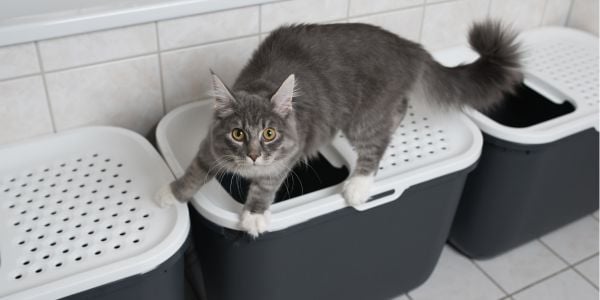
WARNING: If you notice or suspect your cat, especially if male, is having issues urinating, such as straining to pee, crying when peeing, or having bloody urine, seek veterinary care immediately.
This is an absolute emergency, and time is of the essence.
Feline Lower Urinary Tract Disorder (FLUTD) is a term used to describe a range of conditions, from mild to serious, that affect a cat’s bladder and urethra.
It is a relatively common reason people bring their cats to see the veterinarian. Surveys have shown that it is the number one reason why cats are taken to a veterinary hospital. About 1 to 3 percent of cats are affected each year.
FLUTD can be a frustrating problem for both cats and cat owners. This is especially true since one of the common signs and cat behaviors is inappropriate elimination (urinating outside the litter box).
In fact, cats urinating outside the litter box is the leading reason cat owners relinquish their cats to shelters or rescues. But with understanding and patience, this issue can be worked through.
Understanding what FLUTD is and recognizing its symptoms is essential because, if left untreated, it can be life-threatening.
Skip to section:
What Is the Cause of Feline Lower Urinary Tract Disorder (FLUTD)?
There is generally more than one cause of FLUTD. Proper identification of the cause can lead to the fastest resolution and prevention of future episodes, saving your cat pain and discomfort and saving time, money, and stress!
Factors that may bring on this condition include:
- Infections
- Inflammation
- Diet
- Behavioral issues
Common Conditions that Cause FLUTD
Idiopathic Cystitis
This is the term used to describe bladder inflammation from an unknown cause. This is the most common cause of the lower urinary tract signs (LUTS) and accounts for about 60 to 70% of cases.
An important factor in the development of this condition is stress. Things that can cause your cat stress include environmental changes, food schedule changes, and new members in the household (animal or human). See below for ways to manage stress.
Urinary Stones (Uroliths)
These solid collections of minerals (calcium oxalate and magnesium ammonium phosphate) form in a cat’s urinary tract, causing irritation and pain. They can obstruct the bladder, the urethra, or both.
Urethral Blockage
Blockage of the urethra is the most serious of all the causes since it can lead to a potentially life-threatening situation.
Blockages can occur due to stones, crystals, urethral plugs (a combination of proteins, minerals, cells, crystals, and debris that form a ‘plug’), or severe muscle spasms (these occur because of severe inflammation or irritation.
Read more about this serious condition, urethral obstruction (UO). This condition is one where you should not wait to see a veterinarian.
Urinary Tract Infection (UTI)
Infections of the urinary tract can be caused by bacteria, fungi, parasites, and even viruses. Bacterial infections are the most common.
With that said, unlike dogs, bacterial UTIs in cats are not common. Only 1 to 3 percent of young to middle-aged cats are found to have FLUTD caused by bacteria.
The reason the rate is low for young cats is that infection is prevented by the acid content and concentration of their urine.
Cats over 10 years old have a higher incidence, about 10%, since diseases, such as diabetes or kidney disease, alter the acidity and concentration of the urine. Therefore, UTIs can be a more common cause of FLUTD in older cats.
Additional Causes of FLUTD
- Diabetes
- Hyperthyroidism
- Urinary tract (bladder or urethra) tumors – less common
- Injury to the urinary tract or spinal cord – less common
Common Feline Risk Factors for FLUTD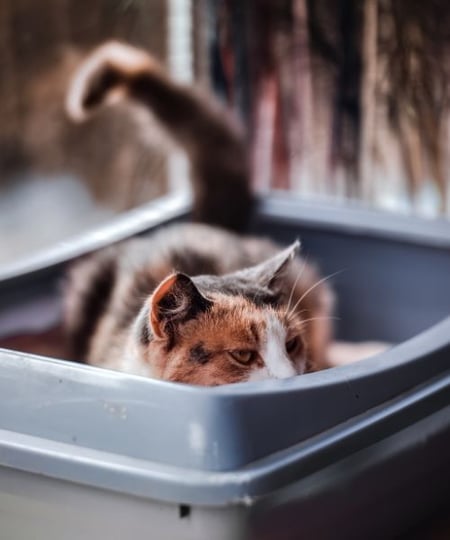
Since there are a variety of causes of FLUTD, cats of any age, breed, and gender can develop the condition. However, the disease is found more commonly in:
- Middle-aged cats
- Neutered cats
- Cats that are above their ideal bodyweight
- Sedentary cats
- Strictly indoor cats
- Cats that eat a dry food diet
What Are the Symptoms of Lower Urinary Tract Disease in Cats?
Most commonly, cat owners will discover urine outside the litter box or notice their cat in the box frequently, straining to go but producing little to no urine.
Cats typically present with one or more of the following signs:
- Difficulty urinating
- Painful urination
- Crying or vocalizing when urinating
- Urinating outside of the litter box
- Urinating frequently
- Blood in the urine
- Excessive licking of the genital region
- General lethargy and/or irritability
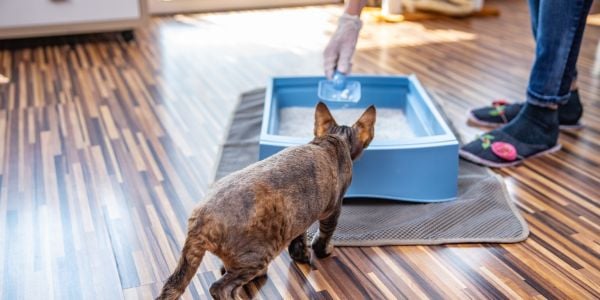
Does Your Cat Have FLUTD?
If you suspect your cat is suffering from lower urinary tract disease, a visit to the veterinarian is essential! If your cat is showing any of the symptoms, they need to be properly diagnosed and helped. There's not much you can do for them at home until you get a proper diagnosis.
Your veterinarian will first complete a full physical exam on your cat to ensure they are otherwise healthy and that no other underlying diseases would interfere with treatment. Additionally, they will be able to palpate your cat’s bladder and kidneys (feel for any abnormalities) and determine if your cat is “blocked” (a urethral obstruction) or if they are in pain.
Your veterinarian will likely obtain a urine sample from your cat in order to look at it under the microscope for the presence of bacteria, blood, or crystals. They will also use testing to determine the urine pH, specific gravity, and presence of a variety of other enzymes.
How to Get a Urine Sample from Your Cat
A sample can be obtained in one of two ways: either a free-catch sample or via a cystocentesis. Your veterinarian will let you know which type of sample they'll want.
“Free catch” samples are collected when a cat urinates, like normal, into a litter box with a non-absorbent litter like NoSorb or Kit4Cat. Your veterinarian may have these products to send home with you to allow you to collect a sample on your own, or they may recommend keeping your cat at the clinic for a few hours to see if the cat will use them there.
For more at-home urine collection tips, check out our article on how to collect your cat’s urine sample.

If you’re using a non-absorbent litter, simply pour the urine into a clean, dry container (ideally a sterile one provided by your veterinarian).
The tricky thing is that these samples are not as sterile (they may collect bacteria from the cat’s fur, the litter box, etc), and it’s hard to know if and when a cat will use the box with a new-to-them litter.
Samples are ideally run within one hour of collection. Older samples, up to four hours old, can be refrigerated while they’re being transported to the veterinarian, but this can cause artifacts and crystals to develop.
The more recent a sample, the better! After an hour, crystals can begin to form artificially, even under refrigeration.
The older a sample, the less sure your veterinarian can be that these crystals are from your cat's bladder versus a result of the sample sitting too long before testing.
Because a fresher, sterile sample is almost always preferred, the second option is cystocentesis. Cystocentesis is using a very small needle and putting it into the bladder through the abdomen wall (like in the photo).
While it sounds a little scary, it’s the same size needle as a vaccine needle and takes just seconds, especially when done in conjunction with an ultrasound for guidance. It does carry some minor risks (such as mild bladder hematoma or urine leakage into the abdomen) but, overall, is generally safe, simple, and well tolerated by cats.
Note: A urinary cystocentesis should not be performed on blocked cats that have a very distended bladder as this can potentially cause it to rupture.
For cats that may have crystals, bladder stones, or evidence of either on preliminary tests, your veterinarian may recommend an ultrasound of the bladder or an x-ray to confirm the presence of a stone in the bladder and/or kidneys.
This is also usually recommended for cats with recurring issues.
How to Treat Feline Lower Urinary Tract Disease?
Lower urinary tract issues in cats are treated in a variety of ways, very specific to each cat’s underlying cause. Your veterinarian will choose a treatment based on your cat’s test results, individual health, history, and lifestyle.
Regardless of the cause, there are some essential key components to managing this condition, regardless of the cause.
Manage Stress
Managing your cat's stress by providing them enrichment and avoiding or lessening exposure to potential stress triggers. If you are struggling or unsure of how to manage your cat’s stress, I would recommend consulting with a feline behaviorist.
Provide Plenty of Water
Be sure your cat is drinking plenty of water. If your cat isn’t a big drinker, read this article to learn about ways to get your cat to drink more.
Medication
Generally, some form of medication is needed for most causes of FLUTD. To make the process less stressful for your cat and you, this article provides some helpful tips for giving pills.
Feline Idiopathic Cystitis
Since inflammation is present in the absence of infection or crystals, these cats are often treated with a multimodal plan.
In addition to anti-inflammatories to reduce inflammation in the bladder and pain medications, your veterinarian may recommend a combination of several things to manage this complicated disease, which may include:
- Special prescription diet formulated to change pH and decrease inflammation
- Supplements, such as capsules or chews containing glucosamine, strengthen the cell layer of the bladder wall
- Stress management via behavioral enrichment and environmental modifications to decrease the severity and frequency of feline idiopathic cystitis (FIC). More on stress management below.
- Pheromonal therapy (such as a Feliway diffuser) and/or calming treats to help calm and relax your cat.
- Increased water/moisture intake with circulating water fountains and all-canned diets (since canned food is 70 to 85% water). Note: If your cat won’t eat canned food (mine never would), you can soak their dry food in water to make it semi-moist.
- Be sure that your cat’s litter box is an adequate size (large), is clean, and that your cat feels safe and comfortable using it. This goes a long way in decreasing their stress. More on setting up litter boxes here.
Pro Tip: Create your own (high-sided) litter box. Most commercial litter boxes are too small. Ideally, you want a box 1 ½ times the length of your cat’s body without their tail.
A great option, especially for high-peers or sprayers, is making a litter box out of a plastic storage tub. Simply remove the lid and use a small saw to cut an opening in the side. Make sure to cover the sharp edges with duct tape, as was done on the box below.
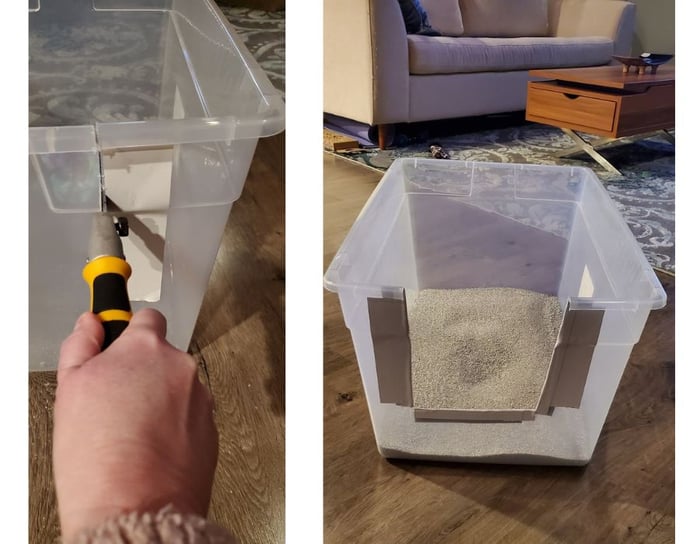
- Avoid changes in your cat’s diet as well their feeding schedules. If it is necessary to change your cat’s diet, be sure to do so very gradually and in their same feeding schedule.
Urinary Stones
The two most common types of uroliths are calcium oxalate and struvite (magnesium ammonium phosphate). Struvite crystals and stones can be dissolved with a prescription stone-dissolving diet. Surgical removal is necessary for calcium oxalate stones as well as struvite stones that fail to dissolve with diet.
Cats with stones must remain on a prescription diet for life to prevent reoccurrence. These prescription-level diets are designed to maintain a specific urinary pH, making the cat’s bladder a less inviting environment for crystals and stones to form.
In addition, the diets contain higher levels of antioxidant fatty acids to reduce inflammation naturally, and in some cases, potassium citrate to help make urine less acidic. Finally, and most importantly, these diets have very controlled levels of minerals often found in bladder stones, like magnesium, calcium, and phosphorus.
The presence of stones or crystals can sometimes cause urinary tract infections, which require treatment with antibiotics. Even if your cat seems to improve within a couple of days of starting medications, it is critical to finish all the medication prescribed as well as have your cat rechecked by your veterinarian.
See below for the best way to increase the effectiveness of your cat’s antibiotics.
Often, these cats are uncomfortable and have inflammation. Therefore, your veterinarian will likely prescribe anti-inflammatories and medication.
Urethral Blockage
If left untreated, a urethral blockage can cause acute kidney failure within 2 to 3 days and death within 24 to 48 hours once there is complete obstruction.
Treatment involves relieving the obstruction. While your cat is under anesthesia, a urinary catheter is passed up the urethra in an attempt to push the stones, crystals, or plug into the bladder.
Due to the resulting inflammation from the procedure, there can be significant swelling and urethral muscle spasms. Therefore, most cats are hospitalized for several days so that the urinary catheter can remain in place, as well as supportive care (intravenous fluids and medications) and monitoring can be provided.
For cats that had severe and extended obstructions, several weeks of hospitalization may be necessary.
For male cats with multiple occurrences that can’t be managed medically or they are unable to be unblocked, your veterinarian may recommend that your cat have a procedure called perineal urethrostomy (PU).
This procedure causes a permanent opening so that stones, crystals, or plugs can easily pass.
The video below is from when our team member's cat, Mazel, who was recovering from a urethral obstruction and was still showing signs of straining while peeing. When he first was experiencing symptoms, he became very vocal and would yowl.
His eyes would also get wide with pain. A cat who displays these symptoms needs to be seen by a vet immediately. It is a matter of life and death. Thankfully, Mazel recovered well after a few nights in the veterinary ER.
Urinary Tract Infections
For true infections where bacteria is confirmed to be present, your veterinarian will likely prescribe oral antibiotics or a long-lasting antibiotic injection to treat the infection. They may also prescribe anti-inflammatories and pain medications to reduce inflammation in the bladder and the discomfort for your cat.
Be sure to give any medications prescribed with food unless told otherwise.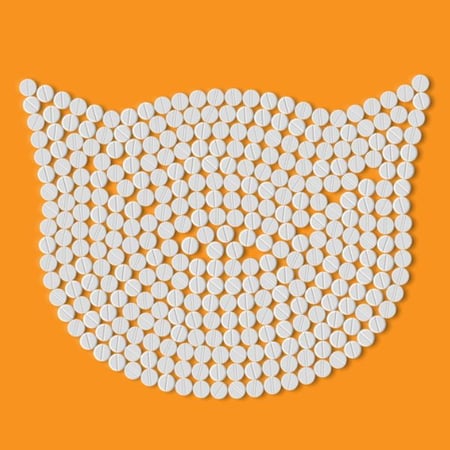
Note: UTIs in male cats can sometimes lead to urinary obstruction, a life-threatening emergency.
To avoid costly treatments and frustrating behaviors from developing, seeking veterinary care promptly is ideal.
Pro Tip: Did you know that there is one simple step you can take that can increase the effectiveness of your pet's UTI antibiotic? There is, and it's as simple as timing.
By giving the antibiotic after their first-morning pee and/or after their last pee of the evening, you ensure that the antibiotic has the longest possible stay within your pet's bladder, as they're not peeing it out.
The bladder is where the medication is needed to do its job most effectively, and this could save you money on not having to give antibiotics for a longer period of time.
This tip is useful regardless of whether the antibiotic is a "once a day" or "twice a day" medication. Talk to your veterinarian and give it a shot.
Are There Any Home Remedies for Cat UTIs?
Unfortunately, there is no good way to treat your cat’s lower urinary tract issues at home. Particularly in this instance, where medical issues can quickly lead to behavioral issues like peeing outside of the box, it’s important to get your cat to the veterinarian as soon as possible to determine the cause and treatment(s).
If you're thinking about using cranberry to treat your cat's UTI, read this article first!
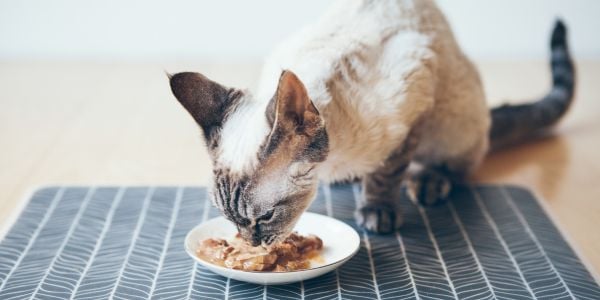
How to Prevent Your Cat From Having Recurring Episodes of FLUTD
Unfortunately, some cats will frequently experience reoccurrences of bladder inflammation, re-obstruction, or uroliths.
As mentioned before, stress management is an important component in reducing the frequency, severity, and duration of these episodes. Finding ways to help manage your cat’s stress is critical. Play, enrichment, and environmental changes are the best ways to do this.
Play is vital for all cats, even those with limited mobility. Just be sure to adjust the intensity and length of play accordingly. Any play is great, whether it’s self-play or interactive.
But you definitely want to include a specific type of play that takes cats through their natural hunting sequence. You can learn all about using the prey sequence here.
You can also encourage more self-play from your cat by putting about half their toys away. This allows you to rotate a few toys in and out each week, so there’s always something “new” to spark interest in play.
Enrichment is really anything that gets your cat using their brain and can include things like:
- Setting up perches at windows, with birdfeeders outside to attract wildlife.
- Mental work like teaching your cat something (clicker training is so much fun!)
- Food puzzles (start easy and gradually increase the difficulty as they master it).
- Hiding treats for them to find (great to do before you head out for the day, so your cat has something to do while you’re gone).
- Letting your cat watch “cat videos” of birds, mice, and squirrels (Preventive Vet has some on our FurLife YouTube channel).
Environmental modifications are small changes you can make to help meet your cat’s natural, instinctual needs a bit better. You can also put emotional modifications in this category if your cat has particular stressors around fear or tense relationships.
- Having multiples of key resources (food, water, litter boxes, resting spots, high perches, hiding spots, scratchers).
- Positioning resources so your cat can’t be easily blocked or trapped when trying to access them, especially if you have another pet at home.
- Adjusting your litter box set-up (including the number of boxes) and its maintenance go a long way in helping lessen your cat’s stress and manage this condition.
- Helping your cat get comfortable with things that scare them, like knocks at the door or loud sounds.
- Working on any tense relationships, whether they’re cat-to-cat, cat-to-dog, cat-to-adult, or cat-to-child.
- Managing the human stress in the home (cats can be greatly impacted by our emotional state).
- Helping to build confidence if your cat is generally anxious.
Additionally, providing your cat with the diet recommended by your veterinarian can significantly help with the different causes of lower urinary tract disorders.
I cannot stress enough how important it is for your cat to drink plenty of water to maintain proper hydration and help regularly flush out their bladder to lessen its exposure to irritating components that cause inflammation.
It can be overwhelming and scary the first time your cat has a lower urinary tract issue. But with some patience and minor adjustments, you (and your cat) can manage this condition.




